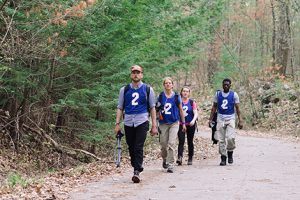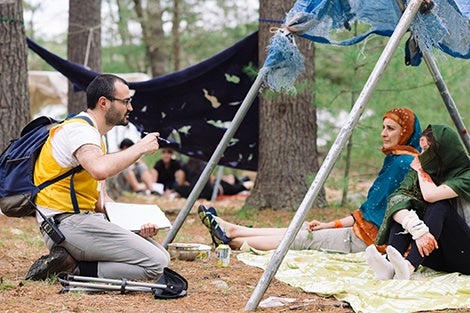At annual disaster simulation, Harvard Humanitarian Initiative stresses personal safety
May 9, 2017 – Amidst unprecedented levels of violence against civilians and humanitarian aid workers in conflict settings around the world, the Harvard Humanitarian Initiative (HHI) is taking a hands-on approach to preparing the next generation of humanitarian responders. For 11 years, HHI has been at the forefront of the humanitarian sector, specializing in field research and experiential humanitarian education.
Every April, more than 300 students, humanitarian professionals, and volunteers put their knowledge to the test at the Humanitarian Academy at Harvard’s multi-day disaster field simulation. This year’s drill was held April 28-30 at Harold Parker State Forest in North Andover, MA. It was organized by The Lavine Family Humanitarian Studies Initiative, the Academy’s flagship training and professional development program. Students from Harvard T.H. Chan School of Public Health, MIT, and Tufts University, and humanitarian professionals who attended the Academy’s two-week Humanitarian Response Intensive Course participated.
“We have a responsibility to prepare the students for the complex issues they will face in the field,” said Michael VanRooyen, HHI director, professor at Harvard Chan School, and chair of emergency medicine at Brigham and Women’s Hospital (BWH). “What we’ve seen in the last several years is that humanitarian safety and security is eroding, and the barriers to providing aid are increasing.”

In 2016 alone, hundreds of humanitarian aid workers were victims of major attacks, including bombings, shootings, kidnappings, and sexual violence. These unprecedented attacks on humanitarian professionals highlight growing insecurity in areas of protracted conflict such as Syria, Yemen, Iraq, and South Sudan.
At this year’s drill, participants camped out in the park for the three days, with no access to cell phones and other electronics, or modern day conveniences. They ate military-style food, and moved from station to station as they faced ever-changing challenges designed to simulate experiences they will face in actual humanitarian response situations.
“Given the increased danger facing aid workers, we want to teach personal safety and professional conduct, but the driving motivator for these students is the desire to just get out there and deliver emergency relief to people in need,” said Stephanie Kayden, director of the Lavine Family Humanitarian Studies Initiative and chief of the Division of International Emergency Medicine and Humanitarian Programs at BWH.
Old rules no longer apply
“The time to learn about humanitarian security is not when you wake up in the field with a gun pointed at you,” said Kayden. She and VanRooyen have spent their careers working as humanitarians in some of the world’s most dangerous places, but they say the landscape is changing. In many places, the old rules that kept aid workers safe no longer apply.
“In this business, we need to stay connected to the reality in the field or we’re irrelevant,” Kayden said. “What the field is telling us is that this generation of humanitarians needs to professionalize their safety and security approach before they start work, instead of thinking they’ll learn the most important lessons on the job. That is a luxury they just won’t have.”
“In today’s humanitarian environment any program that does not teach field security is missing the mark,” she said. “That’s why we partner with some of world’s most experienced security professionals for our Humanitarian Response Intensive Course. Our trainers are able to push the students beyond their comfort zone in a safe but realistic way.”
“Most of the world’s humanitarians get to the field with little or no formal training. That is why it’s so important for us to produce field-ready graduates who are models of humanitarian best practice,” Kayden said.
VanRooyen is confident that HHI’s approach is working. “We’ve been in this for over a decade and we’re sure our students, who now number in the thousands, are sharing knowledge and improving humanitarian response across the sector.”
—Benjamin Davies, Senior Program Manager, Harvard Humanitarian Initiative and Humanitarian Academy at Harvard
photos: Daniel Scarnecchia
